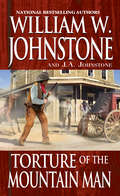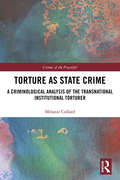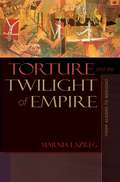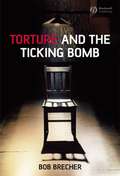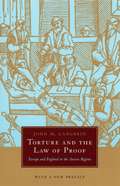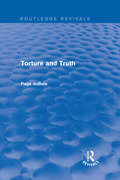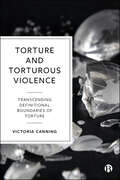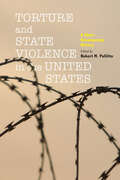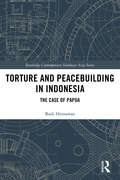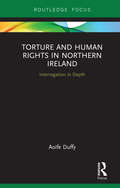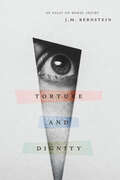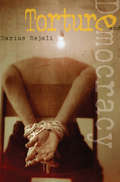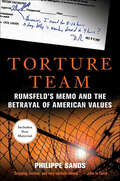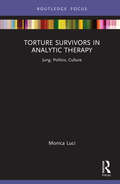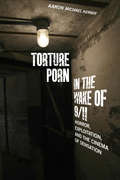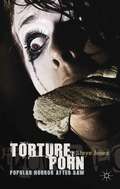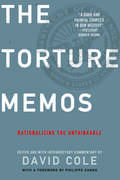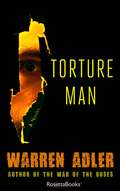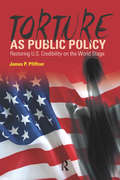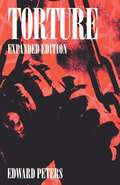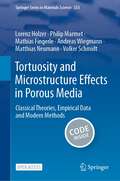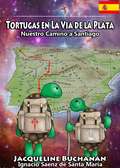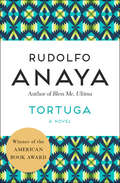- Table View
- List View
Torture of the Mountain Man (Mountain Man #46)
by William W. Johnstone J. A. JohnstoneJohnstone Country. The Good Die Young. The Bad Die Younger. When Smoke Jensen is summoned to a small Texas town under siege by a scourge of kill-crazy bandits, volunteers line up to take out the Mountain Man. Being Smoke Jensen, he wouldn’t have it any other way. A gunshot wound has robbed Audubon, Texas, of its top lawman at the worst possible time. Clete Lanagan and his band of outlaws have hatched a scheme to plunder the town bank of a small fortune in railroad money. When the acting sheriff, Dalton Conyers—half-brother of Smoke’s niece Rebecca—is unable to raise a posse to hunt down Lanagan’s gang, he calls on Smoke for help. But with so much cash at stake, Lanagan won’t go down without a fight. With a bounty on his head, Smoke finds himself marked for death by a legendary gunslinger, a wrathful ranch hand bent on revenge for his brother’s death, and an army of trigger-happy recruits with nothing to lose but their lives. Live Free. Read Hard.
Torture in the National Security Imagination
by Stephanie AtheyReassessing the role of torture in the context of police violence, mass incarceration, and racial capitalism At the midpoint of a century of imperial expansion, marked on one end by the Philippine–American War of 1899–1902 and on the other by post–9/11 debates over waterboarding, the United States embraced a vision of &“national security torture,&” one contrived to cut ties with domestic torture and mass racial terror and to promote torture instead as a minimalist interrogation tool. Torture in the National Security Imagination argues that dispelling this vision requires a new set of questions about the everyday work that torture does for U.S. society. Stephanie Athey describes the role of torture in the proliferation of a U.S. national security stance and imagination: as U.S. domestic tortures were refined in the Philippines at the turn of the twentieth century, then in mid-century counterinsurgency theory and the networks that brought it home in the form of law-and-order policing and mass incarceration. Drawing on examples from news to military reports, legal writing, and activist media, Athey shows that torture must be seen as a colonial legacy with a corporate future, highlighting the centrality of torture to the American empire—including its role in colonial settlement, American Indian boarding schools, and police violence. She brings to the fore the spectators and commentators, the communal energy of violence, and the teams and target groups necessary to a mass undertaking (equipment suppliers, contractors, bureaucrats, university researchers, and profiteers) to demonstrate that, at base, torture is propelled by local social functions, conducted by networked professional collaborations, and publicly supported by a durable social imaginary.
Torture as State Crime: A Criminological Analysis of the Transnational Institutional Torturer (Crimes of the Powerful)
by Melanie CollardCan we understand torture by focusing on the torture chamber or even on the states in which it is practiced, or do we have to consider the wider political context in which it is embedded? This is the central question of this book which explores concepts of state crime for understanding and responding to the indirect use of torture by external nation states. Drawing on the cooperation between France and Argentina in Argentina's Dirty War, this book explores the utility of the concept of state crime for understanding and responding to the indirect use of torture by external nation states with a detailed examination of the exportation of torture techniques and training expertise as complicity in torture. Discussing the institutionalisation of torture in its international structural context, this book focuses on examining three alleged manifestations of the torturer: direct perpetrator, institutional perpetrator, and transnational institutional perpetrator. Important reading for those in the fields of criminology, sociology, international relations and human rights law, this book will also be of key interest to scholars and students in the areas of state crime, human rights and imperialism.
Torture and the Twilight of Empire: From Algiers to Baghdad (Human Rights and Crimes against Humanity #26)
by Marnia LazregTorture and the Twilight of Empire looks at the intimate relationship between torture and colonial domination through a close examination of the French army's coercive tactics during the Algerian war from 1954 to 1962. By tracing the psychological, cultural, and political meanings of torture at the end of the French empire, Marnia Lazreg also sheds new light on the United States and its recourse to torture in Iraq and Afghanistan. This book is nothing less than an anatomy of torture--its methods, justifications, functions, and consequences. Drawing extensively from archives, confessions by former torturers, interviews with former soldiers, and war diaries, as well as writings by Jean-Paul Sartre, Albert Camus, and others, Lazreg argues that occupying nations justify their systematic use of torture as a regrettable but necessary means of saving Western civilization from those who challenge their rule. She shows how torture was central to guerre révolutionnaire, a French theory of modern warfare that called for total war against the subject population and which informed a pacification strategy founded on brutal psychological techniques borrowed from totalitarian movements. Lazreg seeks to understand torture's impact on the Algerian population--especially women--and also on the French troops who became their torturers. She explores the roles Christianity and Islam played in rationalizing these acts, and the ways in which torture became not only routine but even acceptable. Written by a preeminent historical sociologist, Torture and the Twilight of Empire holds particularly disturbing lessons for us today as we carry out the War on Terror.
Torture and the Ticking Bomb (Blackwell Public Philosophy Series)
by Bob BrecherThis timely and passionate book is the first to address itself to Harvard Law Professor Alan Dershowitz’s controversial arguments for the limited use of interrogational torture and its legalisation. Argues that the respectability Dershowitz's arguments confer on the view that torture is a legitimate weapon in the war on terror needs urgently to be countered Takes on the advocates of torture on their own utilitarian grounds Timely and passionately written, in an accessible, jargon-free style Forms part of the provocative and timely Blackwell Public Philosophy series
Torture and the Law of Proof: Europe and England in the Ancien Régime
by John H. LangbeinIn Torture and the Law of Proof John H. Langbein explores the world of the thumbscrew and the rack, engines of torture authorized for investigating crime in European legal systems from medieval times until well into the eighteenth century. Drawing on juristic literature and legal records, Langbein's book, first published in 1977, remains the definitive account of how European legal systems became dependent on the use of torture in their routine criminal procedures, and how they eventually worked themselves free of it. The book has recently taken on an eerie relevance as a consequence of controversial American and British interrogation practices in the Iraq and Afghanistan wars. In a new introduction, Langbein contrasts the "new" law of torture with the older European law and offers some pointed lessons about the difficulty of reconciling coercion with accurate investigation. Embellished with fascinating illustrations of torture devices taken from an eighteenth-century criminal code, this crisply written account will engage all those interested in torture's remarkable grip on European legal history.
Torture and Truth (New Ancient World Ser.)
by Page duBoisFirst published in 1991, this book — through the examination of ancient Greek literary, philosophical and legal texts — analyses how the Athenian torture of slaves emerged from and reinforced the concept of truth as something hidden in the human body. It discusses the tradition of understanding truth as something that is generally concealed and the ideas of ‘secret space’ in both the female body and the Greek temple. This philosophy and practice is related to Greek views of the ‘Other’ (women and outsiders) and considers the role of torture in distinguishing slave and free in ancient Athens. A wide range of perspectives — from Plato to Sartre — are employed to examine the subject.
Torture and Torturous Violence: Transcending Definitions of Torture
by Victoria CanningThere is growing acknowledgement that torture is too narrowly defined in law, and that psychological and/or sexualised violence against women is not adequately recognized as torture. Clearly conceptualising torturous violence, this book offers scholars and practitioners critical reflections on how torture is defined and the implications that narrow definitions may have on survivors. Drawing on over a decade of research and interviews with psychologists, practitioners and women seeking asylum, it sets out the implications of the social silencing of torture, and torturous violence specifically. It invites us to consider alternative ways to understand and address the impacts of physical, sexualized and psychological abuses.
Torture and State Violence in the United States: A Short Documentary History
by Robert M. PallittoThe war on terror has brought to light troubling actions by the United States government which many claim amount to torture. But as this book shows, state-sanctioned violence and degrading, cruel, and unusual punishments have a long and contentious history in the nation. Organized around five broad thematic periods in American history—colonial America and the early republic; slavery and the frontier; imperialism, Jim Crow, and World Wars I and II; the Cold War, Vietnam, and police torture; and the war on terror—this annotated documentary history traces the low and high points of official attitudes toward state violence. Robert M. Pallitto provides a critical introduction, historical context, and brief commentary and then lets the documents speak for themselves. The result is a nearly 400-year history that traces the continuities and changes in debates over the meaning of torture and state violence in the U.S. and shows where state actions and policies have pushed and exceeded constitutional and international normative limits. Rigorously researched—and sometimes chilling—this volume is the first comprehensive reference work on state violence and torture in the U.S.
Torture and Peacebuilding in Indonesia: The Case of Papua (Routledge Contemporary Southeast Asia Series)
by Budi HernawanState-sponsored torture and peacebuilding encapsulate the essence of many of the current conflicts in Indonesia. Papua in particular provides a thought-provoking example of the intricacy and complexity of building peace amidst enduring conflict and violence. This book examines the complex power relations that have constructed the gruesome picture of the fifty-year practice of torture in Papua, as well as the ongoing Papuan peacebuilding movements that resist the domineering power of the Indonesian state over Papuans. Conceptualising ‘theatres of torture and peace’, the book argues that torture in Papua is performed in public by the Indonesian state in order to communicate its policy of terror towards Papuans - it is not meant for extracting information, gaining confessions or exacting punishment. A Torture Dataset is provided, codifying evidence from a broad range of cases, collected through sensitive interviews. In examining the data, the author crafts a new, more holistic framework for analyzing cases of torture and employs an interdisciplinary approach integrating three different theories: Foucault’s theory of governmentality and sovereignty, Kristeva’s theory of abjection and Metz’s theory of memoria passionis (the memory of suffering). The book successfully establishes a new understanding of torture as ‘public theatre’ and offers a new perspective of strengthening the existing Papuan peacebuilding framework of Papua Land of Peace. It will be of interest to academics working on Southeast Asian Studies, Peace and Conflict Studies, Transitional Justice, Peacebuilding, Human Rights and Anthropology of Violence.
Torture and Human Rights in Northern Ireland: Interrogation in Depth
by Aoife DuffyThis book presents a compelling and highly sophisticated politico-legal history of a particular security operation that resulted in one of the most high-profile torture cases in the world. It reveals the extent to which the Ireland v. United Kingdom judgment misrepresents the interrogation system that was developed and utilised in Northern Ireland. Finally, the truth about the operation is presented in a comprehensive narrative, sometimes corroborating secondary literature already in the public domain, but at other times significantly debunking aphorisms, or, indeed, lies that circulated about interrogation in depth. The book sets out the theoretical reference paradigm with respect to the culture and practice of state denial often associated with torture, and uses this model to excavate the buried aspects of this most famous of torture cases. Through the lens of a single operation, conducted twice, it presents a fascinating exposé of the complicated structures of state-sponsored denial designed to hide the truth about the long-term effects of these techniques and the way in which they were authorised.
Torture and Dignity: An Essay on Moral Injury
by J. M. BernsteinIn this unflinching look at the experience of suffering and one of its greatest manifestations--torture--J. M. Bernstein critiques the repressions of traditional moral theory, showing that our morals are not immutable ideals but fragile constructions that depend on our experience of suffering itself. Morals, Bernstein argues, not only guide our conduct but also express the depth of mutual dependence that we share as vulnerable and injurable individuals. Beginning with the attempts to abolish torture in the eighteenth century, and then sensitively examining what is suffered in torture and related transgressions, such as rape, Bernstein elaborates a powerful new conception of moral injury. Crucially, he shows, moral injury always involves an injury to the status of an individual as a person--it is a violent assault against his or her dignity. Elaborating on this critical element of moral injury, he demonstrates that the mutual recognitions of trust form the invisible substance of our moral lives, that dignity is a fragile social possession, and that the perspective of ourselves as potential victims is an ineliminable feature of everyday moral experience.
Torture and Democracy
by Darius RejaliThis is the most comprehensive, and most comprehensively chilling, study of modern torture yet written. Darius Rejali, one of the world's leading experts on torture, takes the reader from the late nineteenth century to the aftermath of Abu Ghraib, from slavery and the electric chair to electrotorture in American inner cities, and from French and British colonial prison cells and the Spanish-American War to the fields of Vietnam, the wars of the Middle East, and the new democracies of Latin America and Europe. As Rejali traces the development and application of one torture technique after another in these settings, he reaches startling conclusions. As the twentieth century progressed, he argues, democracies not only tortured, but set the international pace for torture. Dictatorships may have tortured more, and more indiscriminately, but the United States, Britain, and France pioneered and exported techniques that have become the lingua franca of modern torture: methods that leave no marks. Under the watchful eyes of reporters and human rights activists, low-level authorities in the world's oldest democracies were the first to learn that to scar a victim was to advertise iniquity and invite scandal. Long before the CIA even existed, police and soldiers turned instead to "clean" techniques, such as torture by electricity, ice, water, noise, drugs, and stress positions. As democracy and human rights spread after World War II, so too did these methods. Rejali makes this troubling case in fluid, arresting prose and on the basis of unprecedented research--conducted in multiple languages and on several continents--begun years before most of us had ever heard of Osama bin Laden or Abu Ghraib. The author of a major study of Iranian torture, Rejali also tackles the controversial question of whether torture really works, answering the new apologists for torture point by point. A brave and disturbing book, this is the benchmark against which all future studies of modern torture will be measured.
Torture Team: Rumsfeld's Memo and the Betrayal of American Values
by Philippe SandsThe shocking revelations of the men and women who adopted and enforced Rumsfeld's 2002 memo that paved the way for the inhuman interrogation practices at Guantanamo and Abu Ghraib.On December 2, 2002 the U.S. Secretary of Defense, Donald Rumsfeld, signed his name at the bottom of a document that listed eighteen techniques of interrogation--techniques that defied international definitions of torture. The Rumsfeld Memo authorized the controversial interrogation practices that later migrated to Guantanamo, Afghanistan, Abu Ghraib and elsewhere, as part of the policy of extraordinary rendition. From a behind-the-scenes vantage point, Phillipe Sands investigates how the Rumsfeld Memo set the stage for a divergence from the Geneva Convention and the Torture Convention and holds the individual gatekeepers in the Bush administration accountable for their failure to safeguard international law. The Torture Team delves deep into the Bush administration to reveal:- How the policy of abuse originated with Donald Rumsfeld, Dick Cheney and George W. Bush, and was promoted by their most senior lawyers- Personal accounts, through interview, of those most closely involved in the decisions- How the Joint Chiefs and normal military decision-making processes were circumvented- How Fox TV's 24 contributed to torture planning- How interrogation techniques were approved for use - How the new techniques were used on Mohammed Al Qahtani, alleged to be "the 20th highjacker" - How the senior lawyers who crafted the policy of abuse exposed themselves to the risk of war crimes charges
Torture Survivors in Analytic Therapy: Jung, Politics, Culture (Focus on Jung, Politics and Culture)
by Monica LuciThis important new book introduces and discusses the underpinning of psychodynamic psychotherapy for torture survivors in a clinical setting and incorporates concepts from analytical psychology and other theoretical bases in order to provide readers with a deeper understanding of this complex trauma. Using the concepts of analytical psychology, relational psychoanalysis, and neuroscience, and relying on the theoretical basis of her book Torture, Psychoanalysis and Human Rights (Routledge, 2017), Luci focuses on three key clinical cases and illustrates the therapeutic paths that the therapeutic dyad explore and experiences in order to get out of the patient’s inner prison created or aggravated by the experience of torture. The book discusses the role of the therapist when working with torture survivors, the requirement of a slow and cautious approach when dealing with such trauma, and the importance of a careful and respectful consideration of issues of identity, politics, and culture. Featuring a useful guide, this book will be of great interest to mental health professionals, psychotherapists and students practicing in services that provide assistance to torture and war trauma survivors.
Torture Porn in the Wake of 9/11
by Aaron Michael KernerSaw, Hostel, The Devil's Rejects: this wave of horror movies has been classed under the disparaging label "torture porn." Since David Edelstein coined the term for a New York magazine article a few years after 9/11, many critics have speculated that these movies simply reflect iconic images, anxieties, and sadistic fantasies that have emerged from the War on Terror. In this timely new study, Aaron Kerner challenges that interpretation, arguing that "torture porn" must be understood in a much broader context, as part of a phenomenon that spans multiple media genres and is rooted in a long tradition of American violence. Torture Porn in the Wake of 9/11 tackles a series of tough philosophical, historical, and aesthetic questions: What does it mean to call a film "sadistic," and how has this term been used to shut down critical debate? In what sense does torture porn respond to current events, and in what ways does it draw from much older tropes? How has torture porn been influenced by earlier horror film cycles, from slasher movies to J-horror? And in what ways has the torture porn aesthetic gone mainstream, popping up in everything from the television thriller Dexter to the reality show Hell's Kitchen? Reflecting a deep knowledge and appreciation for the genre, Torture Porn in the Wake of 9/11 is sure to resonate with horror fans. Yet Kerner's arguments should also strike a chord in anyone with an interest in the history of American violence and its current and future ramifications for the War on Terror.
Torture Porn
by Steve JonesThe first monograph to critically engage with the controversial horror film subgenre known as 'torture porn', this book dissects press responses to popular horror and analyses key torture porn films, mapping out the broader conceptual and contextual concerns that shape the meanings of both 'torture' and 'porn'.
Torture Memos
by David ColeOn April 16, 2009, the Justice Department released never-before-seen secret memos describing, in graphic detail, the brutal interrogation techniques used by the CIA under the Bush administration's "war on terror." Now, for the first time, the key documents are compiled in one remarkable volume, showing that the United States government's top attorneys were instrumental in rationalizing acts of torture and cruelty, employing chillingly twisted logic and Orwellian reasoning to authorize what the law absolutely forbids.This collection gives readers an unfiltered look at the tactics approved for use in the CIA's secret overseas prisons--including forcing detainees to stay awake for eleven days straight, slamming them against walls, stripping them naked, locking them in a small box with insects to manipulate their fears, and, of course, waterboarding--and at the incredible arguments advanced to give them a green light. Originally issued in secret by the Office of Legal Counsel between 2002 and 2005, the documents collected here have been edited only to eliminate repetition. They reflect, in their own words, the analysis that guided the legal architects of the Bush administration's interrogation policies.Renowned legal scholar David Cole's introductory essay tells the story behind the memos, and presents a compelling case that instead of demanding that the CIA conform its conduct to the law, the nation's top lawyers contorted the law to conform to the CIA's abusive and patently illegal conduct. He argues eloquently that official accountability for these legal wrongs is essential if the United States is to restore fidelity to the rule of law.
Torture Man
by Warren AdlerThe caller made it clear-$10 million or her daughter's head. The power of unintended consequences sends the privileged life of prominent anti-war activist Sarah Raab crashing down around her. Fear and terror take hold and Sarah turns to former CIA operative Carl Hellmann, a man she has only just met and who stands against everything she has been fighting for. How could this happen? Why would a terrorist group target her family? Confusion turns to fear and anger as Sarah faces the shocking truth lying beneath the surface of her life. And though Carl's interrogation methods violate everything Sarah believes in, they may be the only way to save her daughter's life. Faced with horrific choices, Torture Man takes the reader on a torturous weekend where Wall Street kickbacks, deceit, corruption, and jihad collide on the Upper East Side of New York City.
Torture As Public Policy: Restoring U.S. Credibility on the World Stage
by James P. PfiffnerAfter September 11, 2001 the Bush Administration decided that the most important intelligence about terrorism would come from the interrogation of captives suspected of terrorism. As a result, many detainees were subject to harsh interrogation techniques that at times amounted to torture. Here, James P. Pfiffner authoritatively examines the policy directives, operational decisions, and leadership actions of the Bush Administration that reversed centuries of US policy on the treatment of enemy prisoners. He shows how the serious reservations of career military lawyers about these policies were overcome by the political appointees of the Bush Administration. Pfiffner then analyses the philosophical and legal underpinnings of the policies and practices that have led to the denunciation of the United States' policies by its allies and adversaries throughout the world. Looking ahead, Pfiffner anticipates Obama administration policy changes to restore U.S. credibility and accountability. In all, Torture as Public Policy is a model of detailed policy analysis that demonstrates how greatly public policy matters beyond the back corridors of bureaucracy.
Torture (The\middle Ages Ser.)
by Edward Peters"Torture has ceased to exist," Victor Hugo claimed, with some justification, in 1874. Yet more than a century later, torture is used routinely in one out of every three countries. This book is about torture in Western society from earliest times to the present.A landmark study since its original publication a decade ago, Torture is now available in an expanded and updated paperback edition. Included for the first time is a broad and disturbing selection of documents charting the historical practice of torture from the ancient Romans to the Khmer Rouge.
Tortuosity and Microstructure Effects in Porous Media: Classical Theories, Empirical Data and Modern Methods (Springer Series in Materials Science #333)
by Volker Schmidt Matthias Neumann Lorenz Holzer Philip Marmet Mathias Fingerle Andreas WiegmannThis open access book presents a thorough look at tortuosity and microstructure effects in porous materials. The book delivers a comprehensive review of the subject, summarizing all key results in the field with respect to the underlying theories, empirical data available in the literature, modern methodologies and calculation approaches, and quantitative relationships between microscopic and macroscopic properties. It thoroughly discusses up to 20 different types of tortuosity and introduces a new classification scheme and nomenclature based on direct geometric tortuosities, indirect physics-based tortuosities, and mixed tortuosities (geometric and physics-based). The book also covers recent progress in 3D imaging and image modeling for studying novel aspects of tortuosity and associated transport properties in materials, while providing a comprehensive list of available software packages for practitioners in the community.This book is a must-read for researchers and students in materials science and engineering interested in a deeper understanding of microstructure–property relationships in porous materials. For energy materials in particular, such as lithium-ion batteries, tortuosity is a key microstructural parameter that can greatly impact long-term material performance. Thus, the information laid out in this book will also greatly benefit researchers interested in computational modeling and design of next-generation materials, especially those for sustainability and energy applications.
Tortugas marinas en peligro (¡Arriba la Lectura! Level O #12)
by Kristin CashoreNIMAC-sourced textbook <p><p> ¿Sabías que las tortugas laúd llegan a medir hasta siete pies de largo y pesar hasta 1,200 libras? Lee acerca de las tortugas marinas, entre ellas, la tortuga laúd, la tortuga boba, la tortuga carey, la tortuga lora y muchas más. Y lo que es aún más importante, aprende a protegerlas y evitar que se extingan.
Tortugas en La Vía de la Plata
by Ignacio Sáenz de Santa María Jacqueline BuchananEl Camino de Sevilla a Santiago. Un viaje lleno de vivencias y reflexiones, de unas experiencias personales que te acompañan por los cordiales caminos de España.
Tortuga: A Novel
by Rudolfo AnayaMaster storyteller Rudolfo Anaya explores the world of pain and recovery in this autobiographical novel about an injured teenage boy's journey to overcome suffering--both physical and spiritual When the story opens, the eponymous hero of Rudolfo Anaya's novel is in an ambulance en route to a hospital for crippled children in the New Mexican desert. A poor boy from Albuquerque, sixteen-year-old Tortuga takes his name from the odd, turtle-shaped mountain that is rumored to possess miraculous curative powers. Tortuga is paralyzed, and not even his mother's fervent prayers can heal him. But under the mountain's watchful gaze, with the support of fellow patients, he begins the Herculean task of breaking out of his shell and becoming whole again. Drawn from personal experience and imbued with the magic realism and phantasmagorical vision quests that distinguish Anaya's work, Tortuga is a joyful, life-sustaining book about hope, faith, friendship, and love that celebrates the triumph of the human spirit in the physical world.
